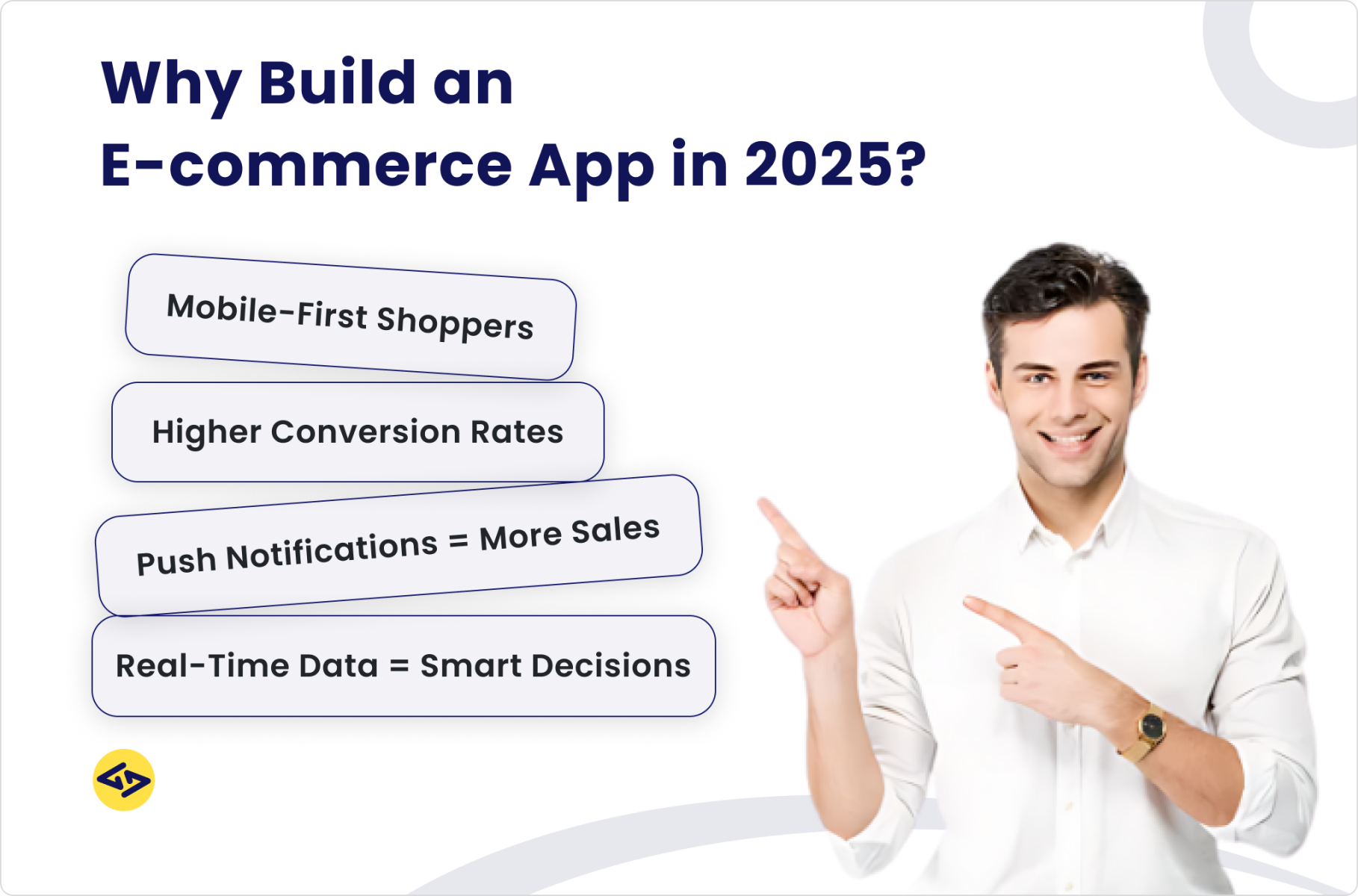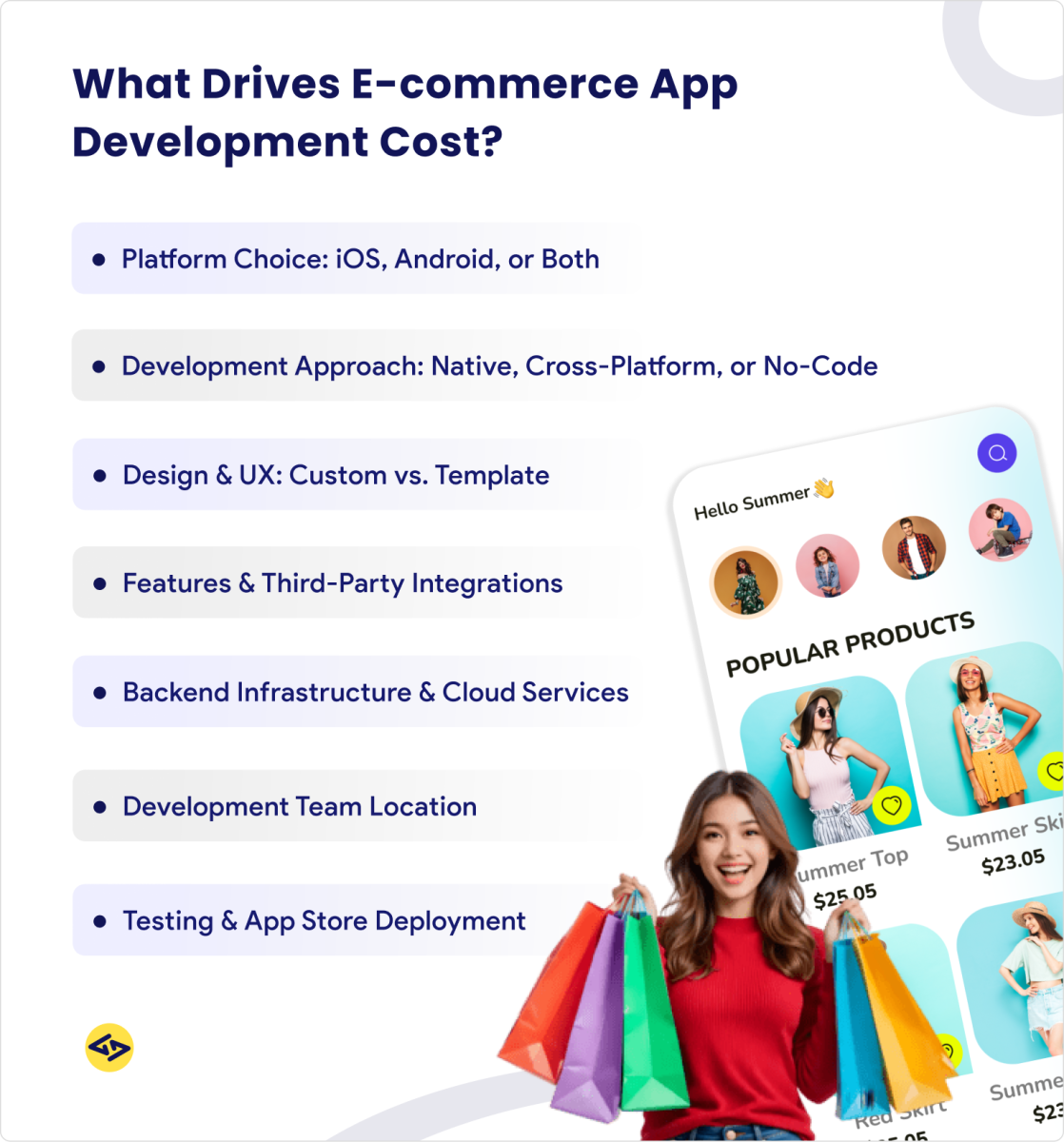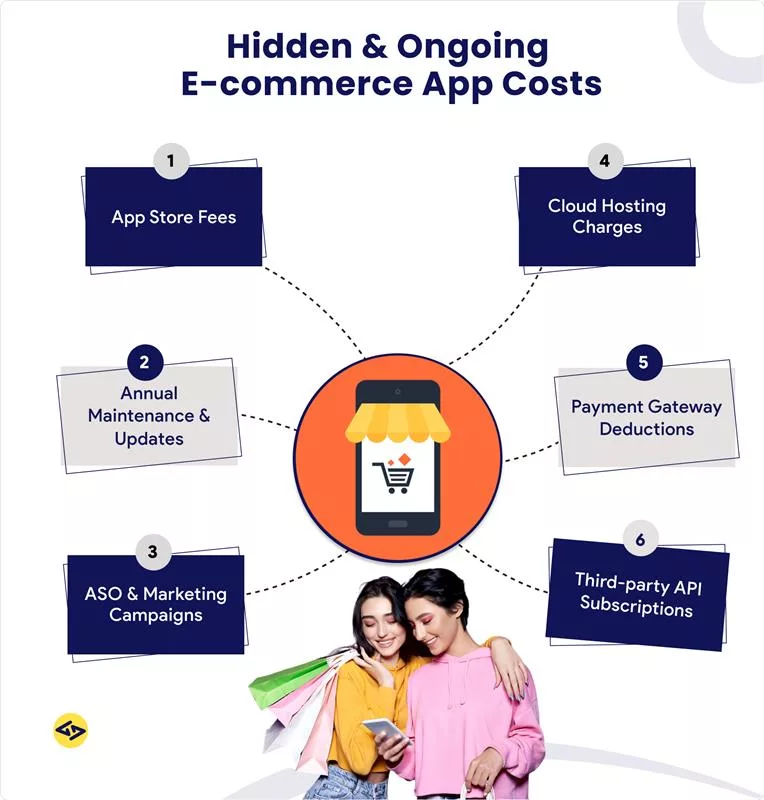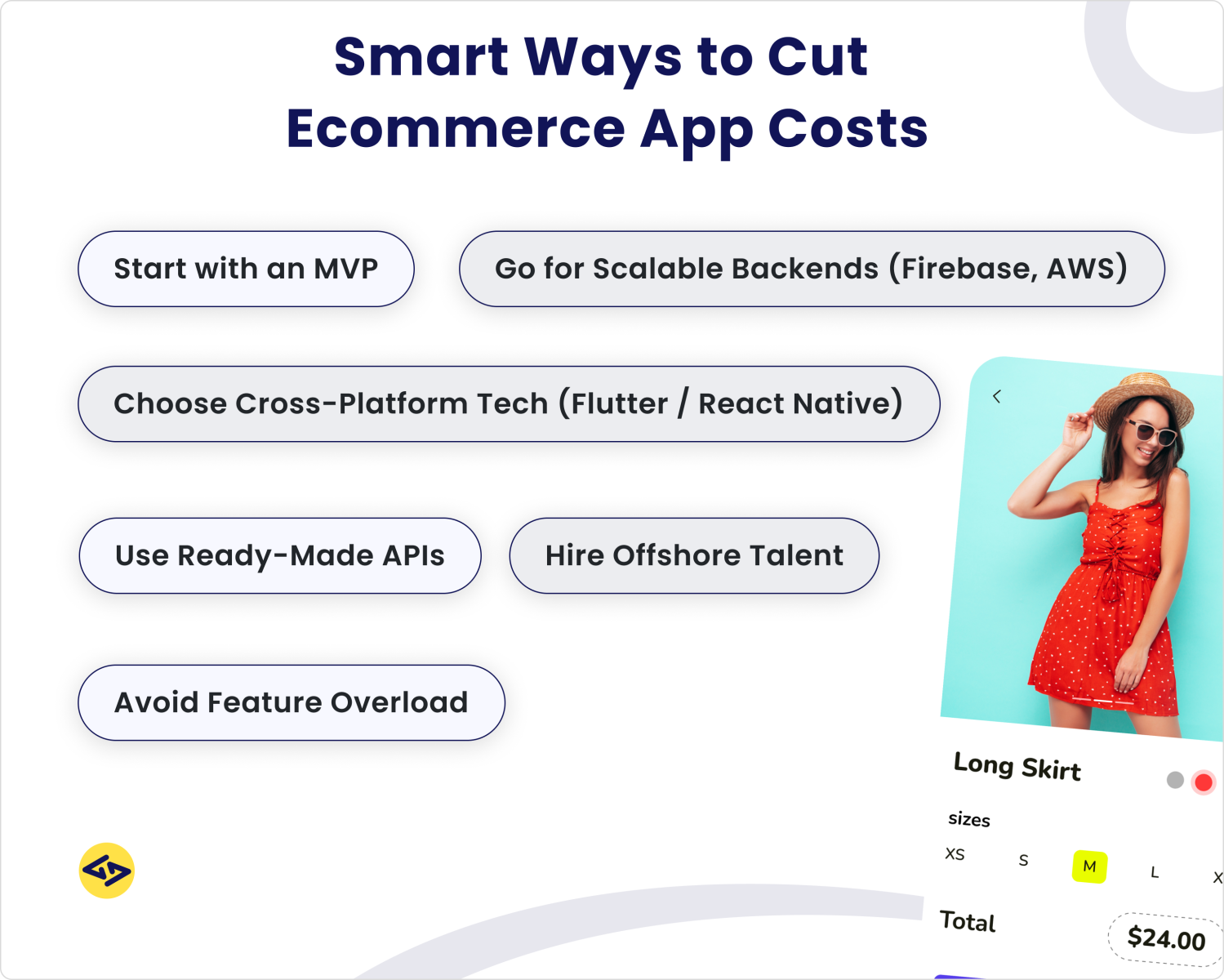Table of Contents
- What is an Ecommerce App?
- Why Build an Ecommerce App in 2026?
- Types of Ecommerce Apps and Their Cost Estimates
- Key Factors That Influence Ecommerce Mobile App Development Cost
- Feature-by-Feature Ecommerce App Cost Breakdown
- Hidden & Ongoing Costs to Consider
- Development Cost by Approach: Native vs Cross-Platform vs No-Code
- Development Timeline for Ecommerce Apps
- Tips to Reduce Ecommerce Mobile App Development Costs
- Conclusion: Turn Your Ecommerce Vision into Reality
- Build Your Ecommerce App With Confidence
In 2026, an e-commerce app is no longer a luxury; it’s a necessity. The world has gone mobile—and so have your customers. A significant majority of global e-commerce sales now come through mobile devices. Mobile-first shopping is the new normal.
Still unsure what it costs to build an e-commerce app? Unlike other guides, we provide comprehensive and transparent insights. This 2026 Ecommerce Mobile App Development Cost Estimator tells you everything you need to know. No fluff—just real, useful insights. And here’s a quick reveal: building an ecommerce app can cost anywhere from $5,000 to over $100,000, depending on your features, design, and development approach.
In this guide, we explore it all: app types, platform choices, feature-wise pricing, hidden and ongoing costs, development timelines, and proven ways to cut costs without cutting quality. By the end, you will know exactly where your budget stands—and how to spend it wisely.
What is an Ecommerce App?
An e-commerce app is a mobile application that enables consumers to search through, choose, and purchase goods or services via their smartphones or tablets. It is structured as an online shop with a mobile-friendly interface.
The essential functions of such apps are typically a product catalog, a shopping cart, safe payment mechanisms, order tracking, and customer support. All these factors combine to provide users with an easy and comfortable shopping experience, while also streamlining business operations.
E-commerce apps in 2026 are more advanced. Application features such as personalized offers, AI-powered product recommendations, AR previews, and one-click buy are now common. These smart tools help brands connect with customers and enhance the entire shopping experience.
Core Functionalities of Ecommerce Apps:
- Product Browse: Advanced search, filters, product categories, and collections.
- Purchasing & Checkout: Secure carts, multiple payment options, and promo code support.
- Order Management: Tracking orders, returns, and refunds.
- Notifications & Communication: Updates about offers, sales, or order status.
- User Profiles: Saved addresses, wishlist, order history, and loyalty points.
Popular Ecommerce App Types:
- B2C (Business-to-Consumer): Direct to individual buyers (e.g., Amazon, Flipkart).
- B2B (Business-to-Business): Selling bulk or wholesale (e.g., Alibaba).
- Subscription-Based: Scheduled deliveries of products/services (e.g., Blue Apron, Spotify).
- Multi-Vendor Marketplaces: Platforms for multiple sellers (e.g., Meesho, Etsy).
These apps enhance convenience and accessibility while enabling businesses to scale their reach and sales exponentially.
Why Build an Ecommerce App in 2026?
The e-commerce industry in 2026 is more competitive and fast-paced than ever. With increasing demand for personalized shopping and faster delivery, a well-optimized mobile app is the key to meeting user expectations.
Key Reasons to Build an Ecommerce App:

- Mobile-First Consumers: Over 80% of consumers prefer mobile over desktop for shopping.
- Increased Conversions: Mobile apps convert users at a significantly higher rate than mobile websites.
- Push Marketing: Drive re-engagement with push notifications for sales, order updates, and offers.
- Data-Driven Insights: Leverage real-time analytics to improve personalization and retention.
Success Stories:
- Nykaa: Leveraged app-based personalization and marketing to reach a $1B valuation.
- Meesho: Scaled rapidly by enabling small sellers to access the e-commerce space via mobile-first technology.
Having an ecommerce app in 2026 is no longer optional—it’s a strategic asset that fuels growth, loyalty, and revenue.
Types of Ecommerce Apps and Their Cost Estimates
| App Type | Description | Estimated Cost |
| Single Vendor | Built for one brand or store | $5,000 – $20,000 |
| Multi-vendor Marketplace | Amazon-style multi-seller app | $20,000 – $100,000+ |
| Subscription Model | Weekly/monthly delivery system | $15,000 – $60,000 |
Each app type comes with its own set of features and architecture, influencing the final development cost. Marketplaces require advanced backend management, while subscription-based apps need recurring billing systems and automated logistics modules.
Key Factors That Influence Ecommerce Mobile App Development Cost
The cost of developing an e-commerce app can greatly differ based on several aspects. The factors that determine pricing are listed below:

Platform (iOS, Android, or Both)
Single Platform: More affordable, ideal for targeting a specific audience.
Both Platforms: Wider reach but doubles development cost unless using a cross-platform framework.
Cross-Platform (Flutter, React Native): A balanced solution offering good performance and cost efficiency, though some limitations compared to native for highly complex features.
Development Method
Native: Best performance, but most expensive.
Cross-Platform: Faster, cheaper, and offers near-native performance, but may require more effort to achieve truly native-like user experience elements.
No-Code/Low-Code: Budget-friendly, but limited scalability and customization.
Design & User Experience
A clean, custom UI/UX increases user engagement but also adds to design and development hours. This factor significantly impacts initial impressions and user satisfaction. Simple templates cost less but may affect branding and retention.
Features & Integrations
The more features on your app (e.g., real-time tracking, multi-language support, AR), the more expensive they are. Additional payments to third parties (payment gateways, analytics, chatbots) are also included in the budget.
Backend Infrastructure
Robust backend systems are needed for inventory, order processing, payments, and analytics. A reliable backend ensures smooth operations and data integrity for all transactions. Cloud services like AWS or Firebase add recurring costs but enhance performance and scalability.
Development Team Location
Rates vary globally:
US/UK/Europe: $100–$200/hour
Eastern Europe: $40–$80/hour
India/Southeast Asia: $20–$40/hour (cost-effective with quality talent)
Testing & Deployment
Thorough testing ensures the app works seamlessly across devices. QA and app store deployment typically add 10–15% to your total cost, but are crucial for user satisfaction and app stability.
Feature-by-Feature Ecommerce App Cost Breakdown
Understanding how much each feature costs can help you plan your budget better. Below is a breakdown of essential ecommerce app features along with their estimated development costs:
User Registration ($1,000 – $3,000): This involves email, mobile number with OTP, or social login. The cost increases with an increased number of login options and security levels.
Product Listings ($2,000 – $6,000): Covers creating categories, product filters, detailed product pages, and images. A dynamic product catalog with custom filters and variations will increase both complexity and cost.
Shopping Cart ($2,000 – $5,000): This includes functionalities like adding/removing items, changing quantities, using a promo code, and checking out. The customer journey is also vital to conversion and requires a coherent and smooth cart, free of bugs.
Secure Payments ($1,500 – $5,000): Popular payment gateway integration using Razorpay, Stripe, or UPI, or Cash on Delivery needs a PCI-compliant system. The budget may increase with the support of different currencies and types of payment.
Order Tracking ($2,000 – $5,000): Allows real-time updates on shipping and dispatch details and delivery. The use of GPS or third-party logistics services will have an effect on cost.
Push Notifications ($1,000 – $3,000): These alerts increase user engagement with offers, order, cart, and delivery status updates. It is faster to incorporate third-party services, such as Firebase or OneSignal, but this may incur additional usage-based costs.
Admin Dashboard ($3,000 – $10,000): A powerful backend for user management, inventory, order, and reporting. The pricing is based on the amount of control and reporting desired on the dashboard.
These are the approximate averages. Custom-made apps with sophisticated features, AI suggestions, or AR tools might be higher as well.
Hidden & Ongoing Costs to Consider
While upfront development costs are important, many hidden and ongoing expenses can affect your long-term budget:

App Store Fees: Publishing on app stores involves platform fees—$25 (one-time) for Google Play and $99/year for Apple Developer.
Cloud Hosting: Services like AWS, Firebase, or DigitalOcean are essential for storing data, media files, and running backend logic. Costs typically range from $20 to $500+ per month, depending on traffic and storage needs.
Payment Gateway Fees: Most payment processors charge a 2–3% fee per transaction. If your app handles high volumes, these charges can accumulate quickly.
Third-party API Licenses: For advanced features like SMS notifications, shipment tracking, maps, or analytics, third-party APIs are used—often billed monthly or by usage.
Maintenance & Updates: Apps require regular maintenance to fix bugs, release new features, and ensure compatibility with OS updates. Expect to spend 15–20% of the original development cost annually.
ASO & Marketing: App Store Optimization, ad campaigns, social media promotions, and influencer collaborations are ongoing investments that drive downloads and engagement. These are often not included in initial development estimates.
Overlooking these costs can lead to underperformance, poor user experience, or unexpected expenses after launch.
Development Cost by Approach: Native vs Cross-Platform vs No-Code
The approach you choose for app development significantly influences your budget and scalability:
Native Development ($30,000 – $100,000+): Native apps are built separately for iOS (Swift) and Android (Kotlin/Java), ensuring top-tier performance and deep access to device features. However, it requires two codebases—doubling the effort and cost.
Cross-Platform Development ($20,000 – $60,000): Tools like Flutter and React Native allow for a single codebase across both platforms. This reduces time and cost while still offering near-native performance, though some device-specific features may be harder to implement.
No-code/Low-code Builders ($5,000 – $15,000): Ideal for MVPs or simple ecommerce apps, platforms like Adalo or Bubble help launch quickly. However, these apps may lack scalability, advanced security, and custom design options.
Your choice should align with your goals, the complexity of features, and your future roadmap. For scalability and long-term growth, native or cross-platform is typically recommended.
Development Timeline for Ecommerce Apps
The time taken to build an e-commerce app depends on its complexity and scope. Here’s a general timeline:
| Stage | Typical Duration |
| MVP Development | 6 – 10 weeks |
| Full App Build | 3 – 6 months |
| Post-launch Enhancements | Ongoing |
MVP (Minimum Viable Product): Includes core features like product listing, cart, checkout, and payments—enough to test market demand and get user feedback.
Full Build: Adds advanced features such as user profiles, recommendations, loyalty programs, and admin dashboards.
Ongoing Updates: Once launched, regular updates are essential for fixing bugs, adding new features, and responding to market trends.
A successful ecommerce app is never really “finished”—it evolves with user feedback, technology changes, and your business goals.
Tips to Reduce Ecommerce Mobile App Development Costs

Begin with MVP: Prioritize the development of core functionality. Test the market, get feedback, and grow to meet needs.
Select Cross-platform Development: With Flutter or React Native, develop one app that can operate on both iOS and Android and save time and the cost of creating two different apps.
Use Built-in APIs: Leverage existing third-party APIs to spend less time building from scratch and more time growing your business.
Take advantage of Scalable Backend Solutions: Services such as Firebase or AWS Amplify enable you to add more infrastructure as the user base grows and avoid a large initial investment.
Contract Offshore Programmers: You can pay a lower hourly development rate without sacrificing quality by working with experienced developers in India or the Philippines, for example.
Escape Feature Creep: Do not clutter an initial version with all sorts of extras. Make sure your scope is small and polish it later on, depending on user action.
With these strategies, it is possible to create a high-performance ecommerce application that is within budget and grows with your business.
Conclusion: Turn Your Ecommerce Vision into Reality
In 2026, creating an e-commerce application is about more than just digitizing a store. It’s about delivering seamless, personalized, and engaging shopping experiences that keep users coming back for more.
Your final budget will depend on key decisions such as platform choice, feature set, app design, development process, and team location, and every decision will impact your ROI.
Depending on the level of complexity and purpose, costs can vary greatly, but acting with knowledge at each step will help you remain within your budget and maximize impact. The technology stack choices and long-term scalability considerations you make today will be crucial in defining your success tomorrow.
If you’re ready to build a high-performing ecommerce app, iCoderz is here to help. Our team specializes in scalable, secure, and customized mobile ecommerce solutions that align with your brand and business needs.
Contact iCoderz today, and let’s turn your e-commerce vision into a successful mobile app.
Build Your Ecommerce App With Confidence
Connect with our experts and discover the exact cost and timeline tailored to your business needs.




